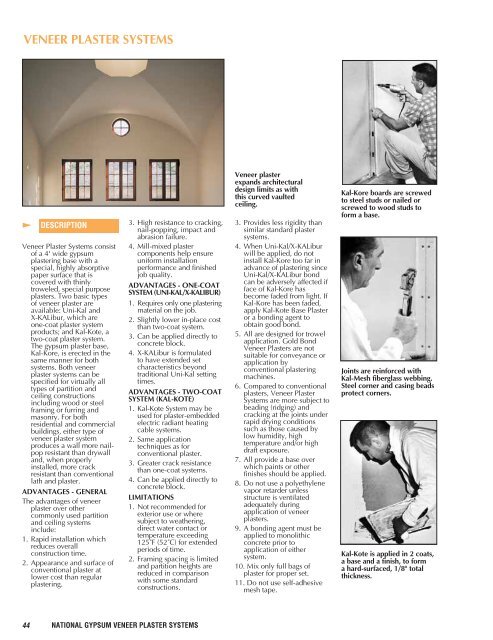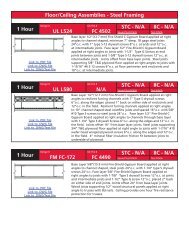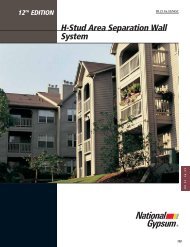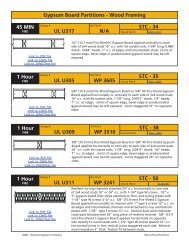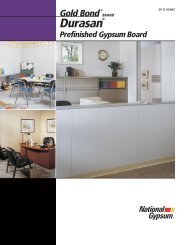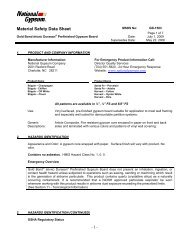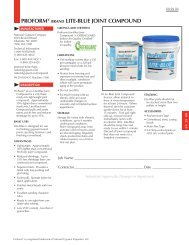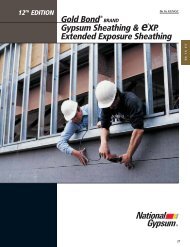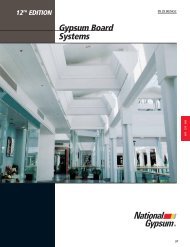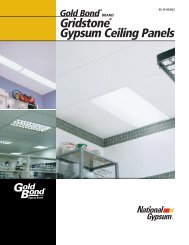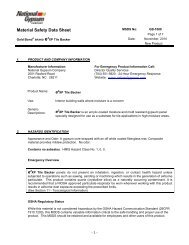National Gypsum Construction Guide - 12th Edition
National Gypsum Construction Guide - 12th Edition
National Gypsum Construction Guide - 12th Edition
You also want an ePaper? Increase the reach of your titles
YUMPU automatically turns print PDFs into web optimized ePapers that Google loves.
VENEER PLASTER SYSTEMS<br />
DESCRIPTION<br />
Veneer Plaster Systems consist<br />
of a 4' wide gypsum<br />
plastering base with a<br />
special, highly absorptive<br />
paper surface that is<br />
covered with thinly<br />
troweled, special purpose<br />
plasters. Two basic types<br />
of veneer plaster are<br />
available: Uni-Kal and<br />
X-KALibur, which are<br />
one-coat plaster system<br />
products; and Kal-Kote, a<br />
two-coat plaster system.<br />
The gypsum plaster base,<br />
Kal-Kore, is erected in the<br />
same manner for both<br />
systems. Both veneer<br />
plaster systems can be<br />
specified for virtually all<br />
types of partition and<br />
ceiling constructions<br />
including wood or steel<br />
framing or furring and<br />
masonry. For both<br />
residential and commercial<br />
buildings, either type of<br />
veneer plaster system<br />
produces a wall more nailpop<br />
resistant than drywall<br />
and, when properly<br />
installed, more crack<br />
resistant than conventional<br />
lath and plaster.<br />
ADVANTAGES - GENERAL<br />
The advantages of veneer<br />
plaster over other<br />
commonly used partition<br />
and ceiling systems<br />
include:<br />
1. Rapid installation which<br />
reduces overall<br />
construction time.<br />
2. Appearance and surface of<br />
conventional plaster at<br />
lower cost than regular<br />
plastering.<br />
3. High resistance to cracking,<br />
nail-popping, impact and<br />
abrasion failure.<br />
4. Mill-mixed plaster<br />
components help ensure<br />
uniform installation<br />
performance and finished<br />
job quality.<br />
ADVANTAGES - ONE-COAT<br />
SYSTEM (UNI-KAL/X-KALIBUR)<br />
1. Requires only one plastering<br />
material on the job.<br />
2. Slightly lower in-place cost<br />
than two-coat system.<br />
3. Can be applied directly to<br />
concrete block.<br />
4. X-KALibur is formulated<br />
to have extended set<br />
characteristics beyond<br />
traditional Uni-Kal setting<br />
times.<br />
ADVANTAGES - TWO-COAT<br />
SYSTEM (KAL-KOTE)<br />
1. Kal-Kote System may be<br />
used for plaster-embedded<br />
electric radiant heating<br />
cable systems.<br />
2. Same application<br />
techniques as for<br />
conventional plaster.<br />
3. Greater crack resistance<br />
than one-coat systems.<br />
4. Can be applied directly to<br />
concrete block.<br />
LIMITATIONS<br />
1. Not recommended for<br />
exterior use or where<br />
subject to weathering,<br />
direct water contact or<br />
temperature exceeding<br />
125˚F (52˚C) for extended<br />
periods of time.<br />
2. Framing spacing is limited<br />
and partition heights are<br />
reduced in comparison<br />
with some standard<br />
constructions.<br />
44 NATIONAL GYPSUM VENEER PLASTER SYSTEMS<br />
Veneer plaster<br />
expands architectural<br />
design limits as with<br />
this curved vaulted<br />
ceiling.<br />
3. Provides less rigidity than<br />
similar standard plaster<br />
systems.<br />
4. When Uni-Kal/X-KALibur<br />
will be applied, do not<br />
install Kal-Kore too far in<br />
advance of plastering since<br />
Uni-Kal/X-KALibur bond<br />
can be adversely affected if<br />
face of Kal-Kore has<br />
become faded from light. If<br />
Kal-Kore has been faded,<br />
apply Kal-Kote Base Plaster<br />
or a bonding agent to<br />
obtain good bond.<br />
5. All are designed for trowel<br />
application. Gold Bond<br />
Veneer Plasters are not<br />
suitable for conveyance or<br />
application by<br />
conventional plastering<br />
machines.<br />
6. Compared to conventional<br />
plasters, Veneer Plaster<br />
Systems are more subject to<br />
beading (ridging) and<br />
cracking at the joints under<br />
rapid drying conditions<br />
such as those caused by<br />
low humidity, high<br />
temperature and/or high<br />
draft exposure.<br />
7. All provide a base over<br />
which paints or other<br />
finishes should be applied.<br />
8. Do not use a polyethylene<br />
vapor retarder unless<br />
structure is ventilated<br />
adequately during<br />
application of veneer<br />
plasters.<br />
9. A bonding agent must be<br />
applied to monolithic<br />
concrete prior to<br />
application of either<br />
system.<br />
10. Mix only full bags of<br />
plaster for proper set.<br />
11. Do not use self-adhesive<br />
mesh tape.<br />
Kal-Kore boards are screwed<br />
to steel studs or nailed or<br />
screwed to wood studs to<br />
form a base.<br />
Joints are reinforced with<br />
Kal-Mesh fiberglass webbing.<br />
Steel corner and casing beads<br />
protect corners.<br />
Kal-Kote is applied in 2 coats,<br />
a base and a finish, to form<br />
a hard-surfaced, 1/8" total<br />
thickness.


